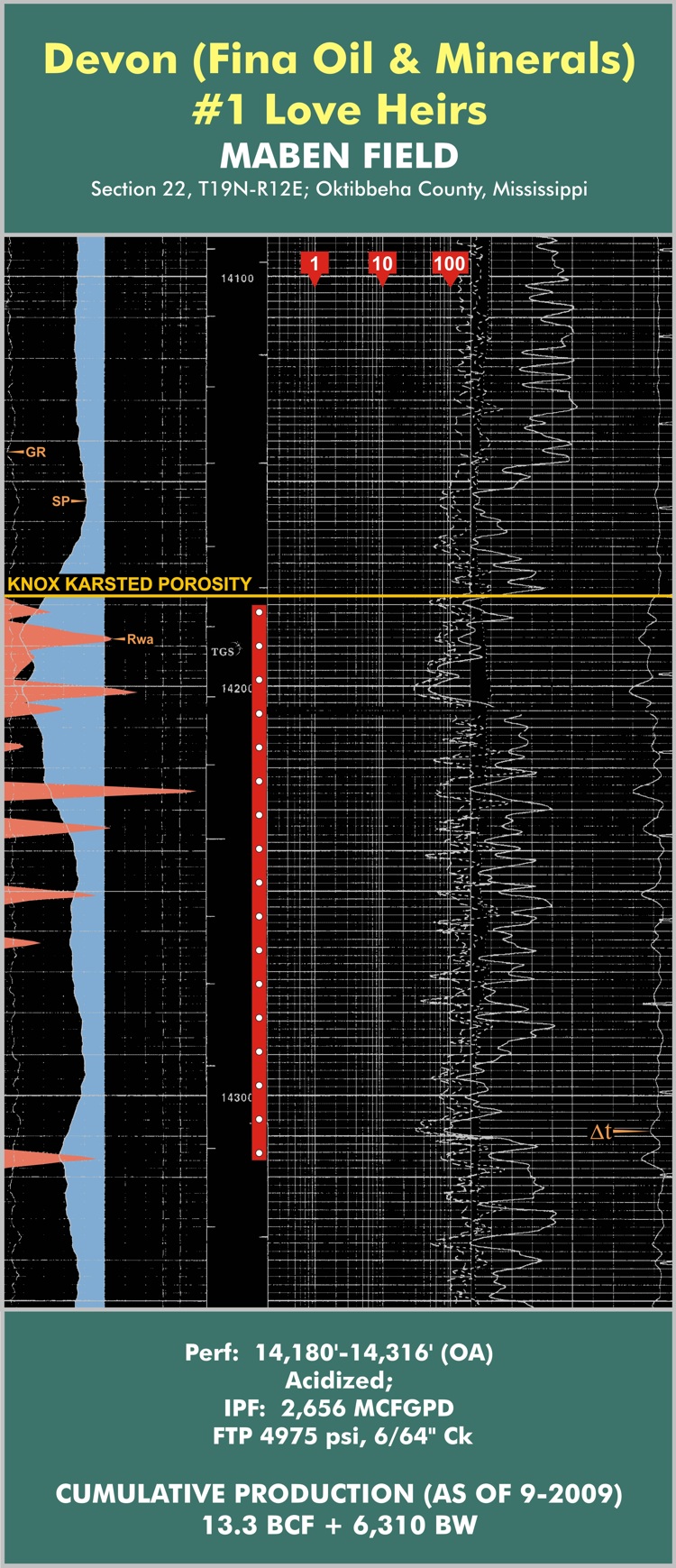WITH FEW PENETRATIONS, THE CAMBRO-ORDOVICIAN IS POORLY UNDERSTOOD
Use the Black Warrior Basin geology links below or the Interior Salt Basin geology links in the left column to navigate to different geologic topics.
|
|
|
|
|
|
|
The Cambro-Ordovician of the Black Warrior Basin can exceed 8,000 feet in total thickness in the north-central area of Mississippi. Despite the general correlation of these sediments to their prolific counterparts in West Texas (Ellenburger) and Oklahoma (Arbuckle), to date only 8,000 barrels of oil and 60 BCF of gas have been produced from the Cambro-Ordovician in the Basin. One well (the Magnolia #1 Snow) accounts for almost all of the 8,000 barrels produced, while one gas field (Maben) accounts for over 97% of the gas produced to date (most of the rest having been produced by a single well in Fairview Field in Lamar County, Alabama). The top of the Lower Ordovician Knox Dolomite in the Basin is typically picked at the first appearance of light gray to tan dolomite containing rounded quartz grains that appear eolian in origin. The overlying Knox Limestone is lighter in color and contains many fossiliferous intervals. The Cambrian Conasauga Shale has recently become the target of a shallow gas play in the overthrust trend near Gadsden, Alabama; however, daily rates have been marginal and the commercial viability of that nascent trend would require gas prices to be greater than $10 / MMBtu. To illustrate how poorly the Cambro-Ordovician of the Basin is understood, it is important to point out that less than 200 wells have penetrated the Ordovician in Mississippi, and only two wells (both drilled 30+ years ago) have penetrated the entirety of the Cambro-Ordovician section.
To date, the only commercial production from Cambro-Ordovician strata in the Basin has been that from Maben Field, located in the deeper part of the Basin in Oktibbeha County, Mississippi. Maben Field was discovered in 1970 with the drilling and completion of the Texaco #1 Sheely, which targeted a large Cambro-Ordovician horst block. The #1 Sheeley was completed as a low-volume "Knox-Ordovician" dry gas well from perforations over a wide interval (14,690' to 15,036'). Following an acid treatment, the well initially potentialed 599 MCFGPD on a 9/64" choke with FTP 1,000 psi. For the next 25 years, the #1 Sheely produced at marginal rates of 100-200 MCFGPD, and was forgotten by most of the industry. However, in the late 1990's a geologist working for Fina noticed the #1 Sheely was exhibiting zero decline and pressure data indicated the well was inefficiently draining a potentially large gas accumulation. Fina leased the surrounding area and in November of 1997 spudded the #1 Sanders, a 15,000' offset to the #1 Sheely. To the amazement of the industry, Fina completed the well (following acid and fracture stimulation) for over 6 MMCFGPD of dry gas, and placed the well on a sustained production rate in excess of 5-6 MMCFGPD. The #1 Sanders has produced over 12.4 BCF (as of September of 2009) and is still producing 1-2 MMCFGPD. Fina and its partners drilled eight more wells at Maben Field, with the #1 Love Heirs being the best well in the field, peaking at a monthly rate in excess of 9 MMCFGPD in November 2000. The #1 Love Heirs has produced over 13.3 BCF (as of September of 2009) and is still producing 1-2 MMCFGPD. Excluding minor production from the Pennsylvanian, Maben Field has produced in excess of 58 BCF by September of 2009.
Petrophysically, open-hole logs from the wells at Maben Field exhibit very poor and limited porosity. It is believed that proximity to the large normal faults that demarcate the horst block is important, in that substantial brecciation occurred along and proximal to the fault planes, contributing to reservoir volume. The producing interval for the best well in the field, the TotalFina ELF #1 Love Heirs, is shown below. Also available for review is Vision's Type Log for the Lower Paleozoic of the Black Warrior Basin of Mississippi, the Magnolia #1 (and #A-1) Snow (shown in reduced form at left); this is the well drilled over 50 years ago in central Monroe County, Mississippi that briefly produced oil from perforations across an interval in the upper Knox (henceforth referred to as the "Snow Zone"; yielding 7,843 barrels of oil before transitioning to water).
Porosity types for the Cambro-Ordovician in the Black Warrior Basin are varied, and besides the primary and brecciated carbonate porosity described above, also include coquinoid (reefal) porosity (as encountered in two wells in Tippah County, Mississippi, karsted porosity (as encountered in many wells), and sandstone porosity (associated more with the older Cambrian Shady Dolostone and Rome Formation). Several periods of pronounced sea-level drop have been manifested in the mottling and karstification of numerous intervals within the Cambro-Ordovician, with the most dramatic karstification being observed in DeSoto County, Mississippi, where long intervals of cavernous (severely karsted) porosity have been encountered. The creation of the karsted porosity that comprises the afore-mentioned "Snow Zone" encountered in central Monroe County, Mississippi also appears to be attributable to a region-wide lowstand (sea level drop) that occurred at or near the end of the Lower Ordovician.
The Cambro-Ordovician is a major hydrocarbon-producing system in practically every Paleozoic basin, world-wide. Given the lack of well control and the abundance of potential traps that have yet to be tested in the Black Warrior Basin, it would appear likely that one or more significant accumulations remain to be found in this thick and highly prospective section.
